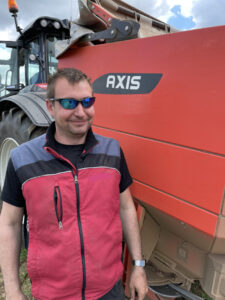A return to a mounted fertiliser spreader after several years running a trailed twin disc machine has improved output, logistics and accuracy for one Lincolnshire farm.
The option of Kuhn’s Electronic Mass Control (EMC) on its Axis twin disc fertiliser spreader was one of the main reasons for Germany Farms to move away from running the trailed machine that it had owned for the past several decades.
It’s a feature that has significantly improved how the fertiliser granules are delivered to the discs and applied to the crop, and has reportedly increased accuracy over a standard hopper with weigh cells. Tom Germany, one of three full time staff members at the farm, explains how it has helped.
“The EMC system monitors the discs rather than weight in the hopper and means we are putting the fertiliser in the right place and at the right rate. The accuracy means we can plan better for applications, and crops are even across the field as they are receiving the same amount of nutrition,” says Tom.
“I recently did a calculation over a 21ha field that we were spreading in. We had a new operator on the seat who was unsure it was applying the fertiliser correctly. At the end of the field, we had 40kg left over, which shows how confident we can be when deciding what to buy for each field.”
Germany Farms is spread over a six-mile radius from its base at Norwell, Lincolnshire. The 2,900ha business grows wheat and barley, with some of the land down to legume fallow. The farm is run in partnership by brothers Chris and John Germany.

Tom Germany
How does EMC work?
Kuhn’s EMC system adjusts the application rate automatically depending on the fertiliser type, rate, and forward speed. It can also allow variable rate application independently to either disc.
Small sensors on each disc monitor the torque drive and adjust the flow of fertiliser to match the required rate. This effectively means that each disc has a weighing device to monitor product flow. As the discs supply readings every second, adjustments are made independently of the operator, and the system can account for lumpy fertiliser. If a blockage occurs, the flow rate is adjusted immediately, or the operator is notified.
Instead of a hopper weigh cell system, which would adjust both outlets together, potentially creating inaccurate application, the EMC will know which outlet has a problem and provide individual correction for it, without affecting the spread pattern on the other side.
Tom says the system works well with the N-sensor as the Axis can quickly adjust each side to the sensor’s requirements.
Returning to mounted
Although the farm had been users of the trailed spreader for several years, it borrowed a mounted spreader following a breakdown of its 5,500-litre twin disc machine in 2018. It highlighted the versatility and comparative output of a mounted setup, despite possessing a slightly lower capacity than the trailed machine. It was enough to convince the farm, and the Kuhn Axis 50.2 H-EMC-W arrived in 2019, through local dealer B&B Tractors.
“Borrowing the mounted spreader really made us think hard about field logistics, which was the one thing that slowed the trailed machine. With the mounted spreader, it’s much easier to open bags whilst standing on the ground without climbing up steps, and the telehander can trundle down the headline tramline to keep the mounted machine going. This wasn’t possible with the trailed, and I’d have to leave the field to fill up.”
Tom says moving to the end of fields to load took time and could potentially run crop down. The mounted is much more manoeuvrable and adds flexibility to the system, with more options to load bags in tight gateways or yards.
Output hasn’t suffered either. The Kuhn Axis 50.2 was ordered with 600kg hopper extensions, so the farm can fit four, one tonne bags in the hopper, whilst still having 600kg on board. This makes a massive difference in some of the larger fields when they are applying nitrogen at over 200kg/ha.
“My best daily output with the trailed spreader was 400ha, but with the Axis I’ve spread 520ha in the same period. Having fertiliser brought to the field is essential to cover the ground quickly when the weather allows, and loading with flexibility has made such a difference,” says Tom.
“We also aren’t making the ruts we used to with the trailed on the first pass. I run the spreader on a Fendt 828 with Vario Grip so I can adjust the pressures to suit the weight of the spreader as it gets lighter during work, and heavier following fill-ups. This helps to reduce the impact of carrying a mounted machine.”
 CCI screen
CCI screen
Although the Fendt tractor could run the Axis spreader though the Isobus system, the farm has purchased Kuhn’s CCI 1200 12in screen, to enable all machines to run the Axis with the same level of accuracy.
Tom says that only paying for one section control unlock, which unlocks the screen rather than the tractor, has saved thousands of pounds and provided flexibility should there be a tractor out of action.
Working through the CCI screen, the Axis has up to 36 sections that can be individually controlled via the GPS, which is far greater than the control through a tractor’s Isobus system. There are different views with maps, machine readouts and settings, and cameras, all possible.
Tom also highlights the benefits of KUHN’s SpreadSet app, which simplifies operation. By entering the spreader settings and choosing the correct fertiliser type, the app has preloaded settings for many of the common fertiliser types, which it then advises the operator on. Tom says it’s only a simple addition but can make a huge difference for quickly setting up the spreader when changing between different fertilisers.


